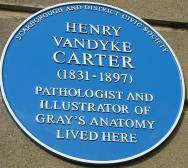Henry VanDyke Carter
Blue Plaque at no 2 Belgrave Crescent Scarborough
In June 2008 a Blue Plaque was unveiled in honour of former Scarborough Artist and Surgeon, Henry Vandyke Carter, who illustrated and contributed to the research of the most famous anatomy textbook in the world. The event was to mark the 150th anniversary of the first publication in 1858 of Gray's Anatomy. Henry Vandyke Carter had a distinguished medical career culminating in his appointment as an Honorary Physician to Queen Victoria. H V Carter lived here with his wife and two children from 1891 until his death in 1897. His wife and children continued to live in the house until 1916.
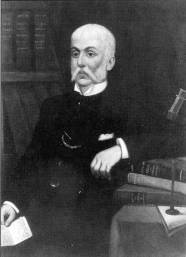
Henry Vandyke Carter
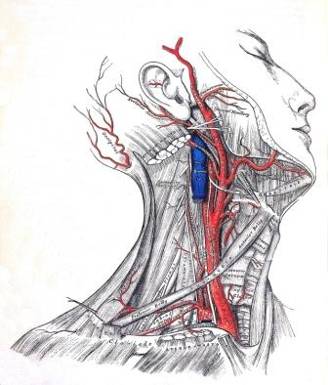
Gray's Anatomy Illustration
Henry’s schooldays were spent at Hull Grammar School, where his uncle, John Dawson Sollitt, was a teacher. Sollitt had a special interest in science and probably encouraged Henry to choose medicine as his life’s work. On leaving school he went to London where he attended St George's Hospital Medical School and qualified in medicine in 1852. After studying in Paris, Henry became a demonstrator in human anatomy at St George’s Hospital. Here he became acquainted with Henry Gray, and when Gray began work on his textbook of anatomy he relied on Carter to assist him with the dissections and then make the drawings required. Despite Henry’s commitment to this demanding task, he succeeded in obtaining the MD of London University in 1856. The completed manuscript and illustrations for Gray’s Anatomy was submitted to the publishers at the end of 1857, but Henry Vandyke Carter was unable to share in the celebration of this great work being published in 1858 because he no longer lived in England.
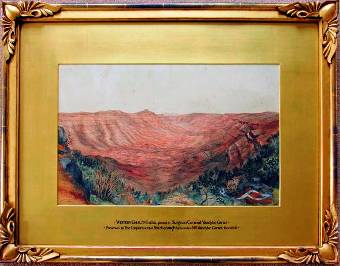
Western Ghauts, India, painted by Surgeon General Vandyke Carter Presented to the Corporation of Scarborough by his widow Mrs Vandyke Carter 1898 (by kind permission of the Scarborough Museum trust)
At this time Henry’s own health was failing. He was suffering from pulmonary tuberculosis and had to take a year’s sick leave in England. Carter returned to Bombay in 1884 and resumed his former duties until he finally retired to Scarborough in 1888. Two years after his retirement he became Deputy Surgeon General and was made Honorary Physician to Queen Victoria.
In 1890 Henry married Mary Robison, who was his junior by 25 years. They began their married life in our offices at No 2 Belgrave Crescent. A year later their son, Henry Robison Carter, was born, followed four years later by daughter, Mary Margaret Carter. Sadly, Henry was not able to enjoy this new family life for long because his tuberculosis was causing a rapid decline in his health and strength.
Henry died on 14 May 1897, a few days before his 66th birthday, in Belgrave Crescent and is buried in Dean Road Cemetery.
An obituary published in The British Medical Journal reviewed Henry Vandyke Carter’s 30 years of service in India and his contributions to medical knowledge. The following is a very brief except:
“Few men have done so much for
tropical pathology as Vandyke Carter. A keen
observer, a skilled histologist, a good draughtsman,
persevering and industrious in a high degree, and well
abreast of the pathological knowledge of the day, he
made full use of his opportunities during his long
service in India, and shed much light on many
interesting and obscure problems in medicine. He
was endowed with the true scientific spirit,
industrious in collecting facts, accurate in observing
and recording them, sagacious in interpretation, not
jumping to conclusions. ….
“When we reflect on the disadvantages of having to
work in a trying climate, often with imperfect
apparatus, without skilled assistance or appreciative
companionship, and without the stimulus of competition
or necessity, and far removed from libraries and many
of the resources of civilisation, we cannot fail to be
impressed by the high quality and the prodigious
amount of valuable and disinterested scientific work
which Vandyke Carter did for his profession.”
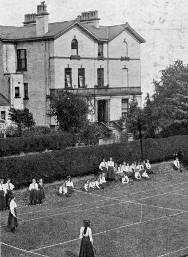
The 1891 Census shows Henry Vandyke Carter, retired surgeon from the Indian Army, at the age of 56 living at No 2 Belgrave Crescent with his wife Mary aged 34 and his sister-in-law Margaret Robison with a cook and a housemaid.
Next door at No 3 was Ravensworth Lodge Boarding School for Girls which was the home of five schoolmistresses, including French and Music teachers, 26 pupils and four domestic staff.
At No 1 Belgrave Crescent lived Edward Taylor, a retired deputy surgeon, with his wife, mother-in-law, daughter and four domestic staff.
In 1917 No 2 Belgrave Crescent was bought by Frederick William Plaxton, builder and founder of Plaxtons’ famous coaches.
John Alfred Bryden, bought the premises in 1963 to use as offices for his firm of Chartered Accountants, Bryden and Co, and the building continues to be used for this purpose. With changes in partners and mergers over the years Bryden and co became Coulson and co, Coulsons, and currently Ashby Berry Coulsons.
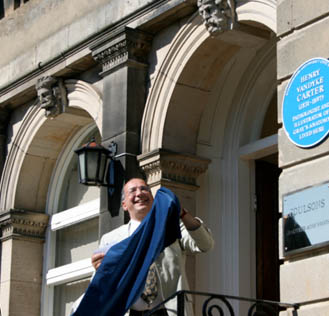
Brian Hurwitz,Unveiling the blue plaque, Professor of Medicine & the Arts, King's College London
Anne and
Paul Bayliss 1997:
“Scarborough Artists of the Nineteenth Century:
A Biographical Dictionary”.
Anne and Paul Bayliss 2005:
“The Medical Profession in Scarborough 1700 to
1899: A Biographical Dictionary”.
Professor Gordon Bell, with Arthur Credland and Ruth
Richardson:
“H B Carter and Sons: Victorian Watercolour
Drawing and the Art of Illustration.” Blackthorn
Press 2006
Ruth
Richardson:
“The Making of Mr Gray’s Anatomy: Bodies, Books,
Fortune, Fame”. Oxford University Press 2008
Shirley
Roberts, Journal of Medical Biography 2000:
“Henry Gray and Henry Vandyke Carter: creators
of a famous textbook”.
